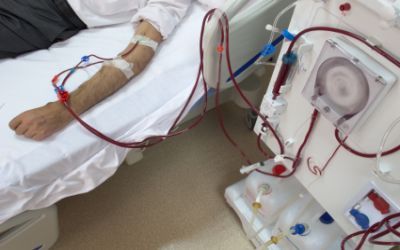Following CDC Protocols Cuts Dialysis Bloodstream Infections in Half


The Centers for Disease Control and Prevention (CDC) has released results of its Dialysis Bloodstream Infection Prevention Collaborative showing a 32 percent decrease in overall bloodstream infections and a 54 percent decrease in vascular access-related bloodstream infections after CDC prevention guidelines were used. Vascular access-related bloodstream infections are those related to devices used to access the bloodstream for hemodialysis. With approximately 37,000 bloodstream infections occurring each year among dialysis patients with central lines, at an estimated cost of $23,000 per hospitalization, wider implementation of the practices in this study could help save lives and reduce excess healthcare spending.
Published in the American Journal of Kidney Diseases, the study looked at data reported to the National Healthcare Safety Network (NHSN) by 17 outpatient dialysis facilities and compared infection rates before and after a set of CDC interventions were consistently used. Interventions included chlorhexidine (an antiseptic for the skin) for catheter exit-site care, staff training and competency assessments focused on catheter care and aseptic technique, hand hygiene and vascular access care audits, and feedback of infection and adherence rates to staff. Facility staff were also encouraged to use antimicrobial ointment on central line exit sites.
"Dialysis patients often have multiple health concerns, and the last thing they need is a bloodstream infection from dialysis, says CDC director Tom Frieden, MD, MPH. These infections are preventable. CDC has simple tools that dialysis facilities can use to help ensure patients have access to the safe healthcare they deserve.
In 2010, more than 380,000 patients in the United States relied on hemodialysis for treatment of their end-stage kidney disease. About 8 in 10 of these patients start treatment with a central line, which is a tube that a doctor usually places in a large vein in a patients neck or chest to give important medical treatment. When not put in correctly or not kept clean, central lines can provide a portal for germs to enter the body and cause bloodstream infections. Other forms of vascular access used for hemodialysis, such as arteriovenous fistulas and grafts, can also put patients at risk for bloodstream infections, but to a lesser extent than central lines.
Although the overall rate of hospitalization among hemodialysis patients has remained relatively stable since 1993, the rate of hospitalization for bloodstream infections has increased 51 percent. A dialysis patient is more than 100 times more likely to get a bloodstream infection from a common resistant bacteria, methicillin-resistant Staphylococcus aureus, than other people. Infections with Staphylococcus aureus can be potentially devastating and can result in hospitalization, death, and serious complications such as endocarditis and osteomyelitis.
To address this critical public health issue, CDC launched a collaborative project in April 2009 to prevent bloodstream infections among dialysis patients and invited outpatient dialysis centers to participate. CDC and the participating dialysis centers worked together to develop and implement the package of interventions to prevent bloodstream infections. The dialysis facilities tracked bloodstream infections in their patients using CDCs National Healthcare Safety Network (NHSN), which is now being used by over 5,000 dialysis facilities nationwide for tracking and prevention of healthcare-associated infections. Â
Dialysis patients are particularly vulnerable to infections, says Dr. Priti Patel, head of CDCs dialysis safety efforts. We now know it is possible to significantly reduce the infections among dialysis patients by following CDCs checklists and tools. If all dialysis facilities nationwide were using the CDC interventions, we could see dramatic reductions in infections and adverse outcomes in this population.
Dialysis facilities can implement many of CDCs recommendations by using a series of checklists and performing observations using audit tools that are currently available on CDCs website. Additionally, CDC has released a free infection prevention course for dialysis nurses and technicians that reviews CDC recommended practices in a convenient, 1-hour self-guided internet training course that also offers continuing education credits.
Preventing bloodstream infections among dialysis patients has been identified as a national priority by the U.S. Department of Health and Human Services. Several initiatives have demonstrated the ability to reduce bloodstream infections in hospital intensive care units, but prior to the CDC Dialysis Bloodstream Infection Prevention Collaborative, there have been few similar initiatives attempted in outpatient settings.
For more information on what CDC is doing to make dialysis safer for patients, visit: www.cdc.gov/dialysis.
To read the full study, visit: http://www.sciencedirect.com/science/article/pii/S0272638613006677.
To access CDCs dialysis infection prevention tools, visit: http://www.cdc.gov/dialysis/prevention-tools/index.html.
Â
Comprehensive Strategies in Wound Care: Insights From Madhavi Ponnapalli, MD
November 22nd 2024Madhavi Ponnapalli, MD, discusses effective wound care strategies, including debridement techniques, offloading modalities, appropriate dressing selection, compression therapy, and nutritional needs for optimal healing outcomes.
Voices of Resilience: Q&A With the Editor of "Corona City: Voices From an Epicenter"
March 1st 2024Step into the diverse and poignant world of "Corona City: Voices From an Epicenter" with editor Lorraine Ash, MA. In this insightful Q&A, learn about the origins of this remarkable anthology, the challenges faced in capturing raw, unfiltered narratives of the COVID-19 pandemic, and the lasting impact of these stories on readers and communities alike.